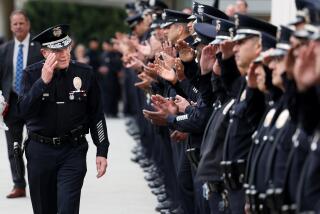Police chiefs see Zazi case as example of citizen anti-terror efforts
- Share via
DENVER — A store clerk’s curiosity about why Najibullah Zazi was buying large quantities of beauty products was an example of the kind of citizen vigilance that can help combat terrorism, law enforcement officials said Saturday.
Los Angeles Police Department Cmdr. Joan McNamara cited the recent case at a Denver meeting of police chiefs, who adopted a model for a nationwide community watch program that teaches people to identify suspicious behavior and encourages them to report it.
Federal authorities allege that Zazi, 24, bought beauty supplies from Denver-area stores in order to make explosives. He has been jailed in New York on charges of conspiracy to detonate a weapon of mass destruction, possibly targeting New York City. Zazi has denied the charges.
Zazi reportedly told an inquisitive clerk that he needed a large amount of cosmetic chemicals because he had “lots of girlfriends.” His purchases weren’t reported to authorities, but the police chiefs said they hoped a coordinated publicity effort would make people think differently about such encounters.
LAPD Chief William J. Bratton, who developed the iWatch program with McNamara, called it the 21st century version of Neighborhood Watch.
The Major Cities Chiefs Assn., headed by Bratton and composed of the chiefs of the 63 largest police departments in the U.S. and Canada, endorsed iWatch at the group’s conference Saturday.
The program would have provided an easy way for that Colorado store clerk and others to report suspicious activity so that police could launch investigations earlier, McNamara said.
“That clerk had a gut instinct that something wasn’t right,” she said.
Using brochures, public service announcements and meetings with community groups, iWatch is designed to deliver concrete advice on how the public can follow the oft-repeated post-Sept. 11 recommendation: “If you see something, say something.”
Program materials list nine types of suspicious behavior that should compel people to call police, and 12 kinds of places to look for it. Among the indicators:
* If you smell chemicals or other fumes.
* If you see someone wearing clothes that are too big and too heavy for the season.
* If you see strangers asking about building security.
* If you see someone purchasing supplies or equipment that could be used to make bombs.
The important places to watch include government buildings, mass gatherings, schools and public transportation.
The program also is designed to ease reporting by providing a toll-free number and Web page that the public can use to alert authorities. Los Angeles put up its website (https://www.iWatchLA.org) this weekend.
“It’s really just common-sense types of things,” Bratton said, adding that his department was providing technical assistance to other agencies that want to adopt the program.
But American Civil Liberties Union policy counsel Mike German, a former FBI agent who worked on terrorism cases, said that the supposed indicators are relatively common. He suspects people will fall back on personal biases and stereotypes of what a terrorist looks like when deciding whether to report someone to the police.
“That just plays into the negative elements of society and doesn’t really help the situation,” German said.
After the Sept. 11 attacks, the Bush administration proposed enlisting postal carriers, gas and electric company workers, telephone repair workers and other workers with access to private homes in a program to report suspicious behavior to the FBI. Privacy advocates condemned that as too intrusive, and the plan was dropped.
Bratton and McNamara said that privacy and civil liberties protections are built into this program.
“We’re not asking people to spy on their neighbors,” McNamara said.
More to Read
Sign up for Essential California
The most important California stories and recommendations in your inbox every morning.
You may occasionally receive promotional content from the Los Angeles Times.













